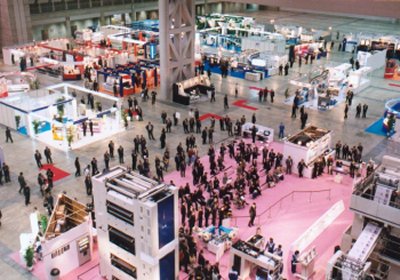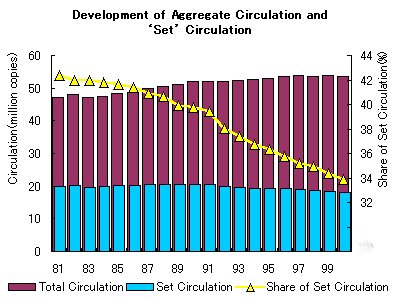|
NSK News Bulletin Online
2001 Japan Newspaper Production Show held in Tokyo The 16th Japan Newspaper Production Show (JANPS) was held for four days starting from There was a lot of interest in new systems for computer-to-plate (CTP) production and NewsML, the proposed standard for transmitting news texts and images. The turnout at this year°«s show hit an all-time high of 19,127. CTP technology is a system for making printing-press plates directly from the data contained in computer-screen layouts of newspaper pages, eliminating the need for film production. New CTP systems were demonstrated by makers including Kaneda Kikai Seisakusho, Ltd., Nippon System Gijutsu Co., Fuji Photo Film Co. and Matsushita Graphic Printing, Inc. The Nikkei, Shinano Mainichi and Kochi newspapers have already adopted CTP systems. In response to complaints about the high costs of materials for specialized plates, Toyo Ink Mfg. Inc. announced that it has developed a CTP system with a German company to utilize cheaper conventional pre-sensitized (PS) plates. The system will go on sale in Japan in June 2002. Among the new systems for upstream production, materials-management systems and newspaper-composition systems using the NewsML and XML international standards for news data drew the most attention. New systems for handling advertisements were also featured, focusing on the electronic data interchange (EDI) protocol for transmission and other transactions involving advertisements in digital form. About 15 companies displayed systems for advertisement management, electronic transmission of advertisement data and color management. Dainippon Screen Mfg. Co. demonstrated an integrated system for the delivery and reception of advertisement data, as well as for direct insertion of ads into newspaper pages, all in digital form. In the field of press and post-press production processes, Tokyo Kikai Seisakusho and Goss Graphic Systems Japan gave live demonstrations of their shaftless rotary press machines. The machines do not use conventional shafts that combine press machines or plate chassis, thereby conserving energy and allowing the installation of the machines in smaller spaces. Some companies demonstrated on-demand printing systems for newspaper printing in remote locations such as isolated islands or for low-volume printing abroad. Sankei Shimbun ending Tokyo Evening Editions The Sankei Shimbun announced on Nov. 7 that as of next April, it will discontinue the evening editions now published at its Tokyo office. The company said its daily newspaper will become a morning-edition-only paper in the Tokyo metropolitan area and adjacent prefectures. The monthly subscription fee, which now covers morning and evening editions, will be cut from 3,850 yen to 2,950 yen. However, Sankei will maintain both its morning and evening editions in the area served by its Osaka office. Sankei Shimbun President Takehiko Kiyohara attributed the decision to a steep decline in readership for its evening editions in the Tokyo metropolitan area. He said that with the change, his company will strive to maintain the essential news in a balanced and well-arranged manner, while expanding analysis and other sections. He said that the Sankei will also take greater advantage of how well-suited newspapers are to browsing and documentation, as well as their usefulness for interpretation and analysis articles. He said that discontinuing evening editions around Tokyo would allow Sankei to provide its same high-quality product at lower prices. According to Audit Bureau of Circulations (ABC) statistics for September, Sankei°«s circulation was about 820,000 for the morning edition and 250,000 for the evening edition in the area covered by the Tokyo office. However, it had a readership of about 1.2 million for the morning edition and 640,000 for the evening edition in the Osaka service area. The circulation of the Tokyo evening edition has fallen more than 100,000 over the past 10 years. The potential loss in circulation and advertising revenues that might result from the cancellation of the evening editions is expected to be offset by increased morning circulation and reduced costs. Sankei aims to boost its morning circulation to 1 million in and around Tokyo to start, and a five-year restructuring plan to begin next year is to cut at least 200 workers in three years and 500 over five years. With some exceptions, Japan°«s daily newspapers have been published and sold as a package-set of morning and evening editions. The custom began around the end of the 19th century. The outbreak of the Russo-Japanese War in 1904 led Japanese readers to check newspapers for breaking news many times a day. The practice of publishing daily newspapers as a set of morning and evening editions has largely continued, except when newsprint was briefly regulated prior to and after World War II. But the °∆set°« circulation of daily newspapers, if the morning and evening editions are The Sankei Shimbun is a national newspaper with dual head offices in Tokyo and Osaka, just like the four other national newspapers -- the Asahi, Mainichi, Yomiuri and Nikkei. The Sankei began publication in 1933 under the title Nippon Kogyo Shimbun (the Japan Industrial Journal). In March 1950, the Sankei began issuing a daily newspaper separately in Tokyo and Osaka, and it introduced the °∆set°« publication system of morning and evening editions in June 1953. Media Organizations Join Celebrations
Crown Princess Masako gave birth to a baby girl at 2:43 p.m. on Dec. 1 at the Imperial Hospital. That evening, major Japanese newspapers distributed extra editions reporting this much-awaited news near major railway terminal stations, at prefectural capitals and other major local cities. Meanwhile, major TV stations suspended regular programs to broadcast special programs on the birth of a baby to the Crown Prince and Princess. The nation°«s three largest newspapers ? Asahi, Mainichi and Yomiuri ? issued 550,000 to 800,000 copies of extra editions, which were much larger in number than their usual extra editions, in major cities all over the country. Nikkei, Sankei and most sports dailies also published extras of the order of 50,000 to 80,000 copies each. The English-language dailies ? The Japan Times and The Daily Yomiuri ? delivered more than 10,000 copies of extras to major hotels in Tokyo and other places. At twilight hours on that weekend day, passers-by at busy downtown areas were falling each other to get copies of the extra editions. Many apparently took home the extra editions as keepsakes. Yomiuri supplied extra editions to Ito-Yokado chain of major retail shops and to All Nippon Airways at their request as for free for their customers. Aside from the major national newspapers, a total of 45 regional newspapers issued extra editions. Meanwhile, NHK and the four major commercial TV stations, with the sole exception of Television Tokyo Channel 12, broadcast special commemorative programs. According to a survey by Video Research Ltd., Channel 12°«s regular program registered a higher viewing rate than the special programs broadcast by other stations ? an indication that the general public might have been rather cold to the feverish coverage of the news by the media organizations. Each media organization had been fully prepared for the birth of the royal baby, which was expected to come sometime between late November and early December. Newspapers stocked advance copies on the premise that extra editions would be published, while TV stations asked friends and acquaintances of the Crown Prince and Princess to stand by for live appearances on special programs. All the reporters at the press club of the Imperial Household Agency had remained °»combat-ready°… since around Nov. 20. Five European Journalists visit Japan Five journalists arrived on Nov. 10 to spend about four weeks in Japan in the 23rd NSK fellowship program for European journalists. The visitors traveled and conducted news-gathering activities on the current state of Japanese politics, the economy and industry. On Nov. 19, they visited the Prime Minister°«s Official Residence to meet Deputy Chief The fellowship program has been offered every fall in cooperation with the Journalists in Europe (JE), a training institute for journalists. The participants in this year°«s program were, from the left, Petya Dikova (24Hours, Bulgaria), Han Dirk Victor Hekking (Het Financieele Dagblad, The Netherlands), Deputy Chief Cabinet Secretary Shinzo Abe, Philip Lote (Norwegian Broadcasting Corporation, Norway), Tuomas Savonen (Finnish News Agency, Finland) and Zvezdana Crnogorac (TV Studio B, Yugoslavia). Japan-U.S. Journalist Exchange rescheduled to February NSK°«s Japan-U.S. journalist-exchange program, which was delayed due to the Sept. 11 terrorist attacks on the United States is being rescheduled to mid-February. U.S. journalists will visit Japan and Japanese journalists will head to the U.S. to be hosted by the International Center for Journalists (ICFJ), based in Washington D.C. The details of the program are still being finalized. Prospective sites for local visits will be chosen for each group of journalists to give participants opportunities to write articles on current topics for their respective publications. Topics.......Topics.......Topics........
|
 Nov. 13 at the Tokyo International Exhibition Center --commonly known as Tokyo Big Sight. The biannual event is sponsored by The Japan Newspaper Publishers and Editors Association in cooperation with manufacturers belonging to the Conference for Japan Newspaper Production Technique-Japan. A total of 44 makers of newspaper production equipment showed off their latest technologies, ranging from labor-saving enhancements for greater efficiency to new systems for multimedia use.
Nov. 13 at the Tokyo International Exhibition Center --commonly known as Tokyo Big Sight. The biannual event is sponsored by The Japan Newspaper Publishers and Editors Association in cooperation with manufacturers belonging to the Conference for Japan Newspaper Production Technique-Japan. A total of 44 makers of newspaper production equipment showed off their latest technologies, ranging from labor-saving enhancements for greater efficiency to new systems for multimedia use. counted as only one paper, has steadily declined over the past 20 years. From 1990 to date, the share of °∆set°« circulation in total newspaper readership has fallen to below 40 percent, leading newspaper companies to try to retain evening editions by changing their editorial content.
counted as only one paper, has steadily declined over the past 20 years. From 1990 to date, the share of °∆set°« circulation in total newspaper readership has fallen to below 40 percent, leading newspaper companies to try to retain evening editions by changing their editorial content.
 Cabinet Secretary Shinzo Abe. In the latter half of the program, the journalists visited Hiroshima City and Kyoto City and had the last 10 days of their visit free for individual reporting. They left for home on Dec. 7.
Cabinet Secretary Shinzo Abe. In the latter half of the program, the journalists visited Hiroshima City and Kyoto City and had the last 10 days of their visit free for individual reporting. They left for home on Dec. 7.